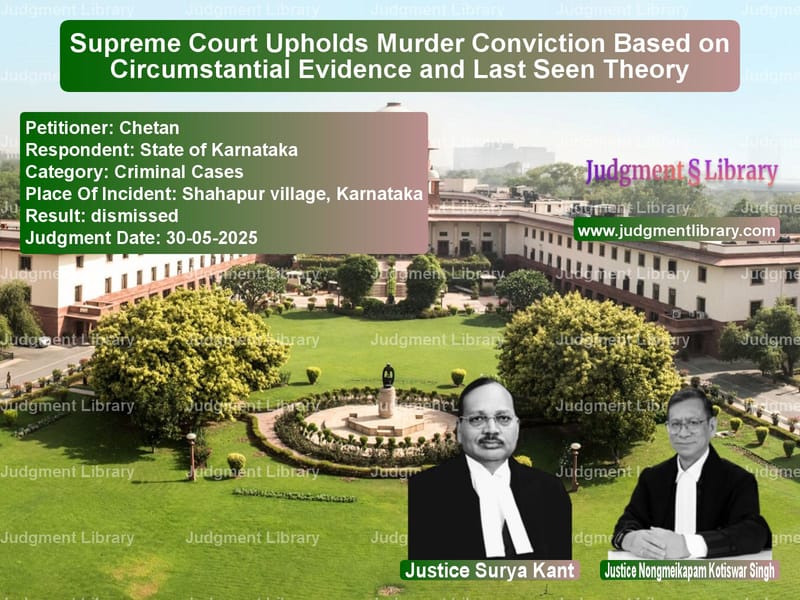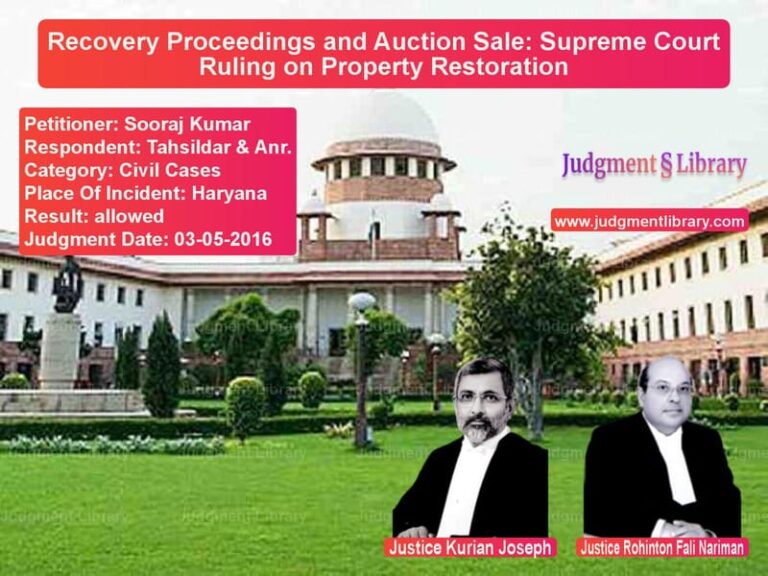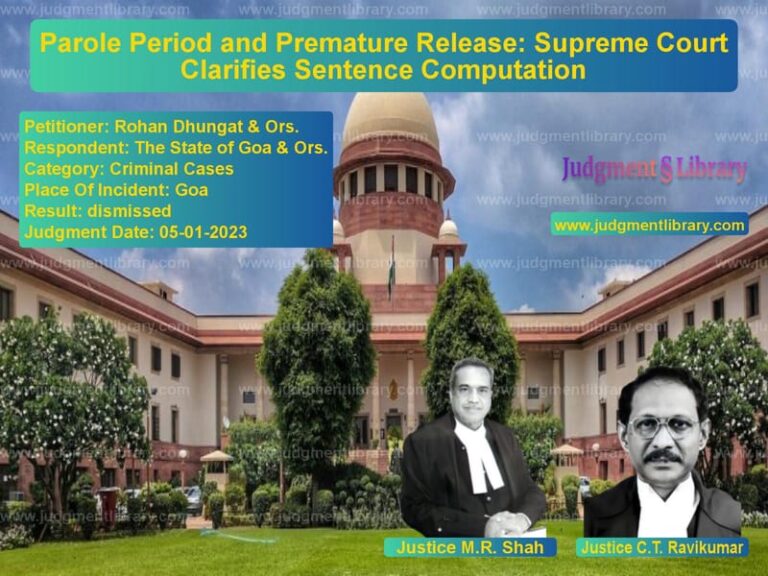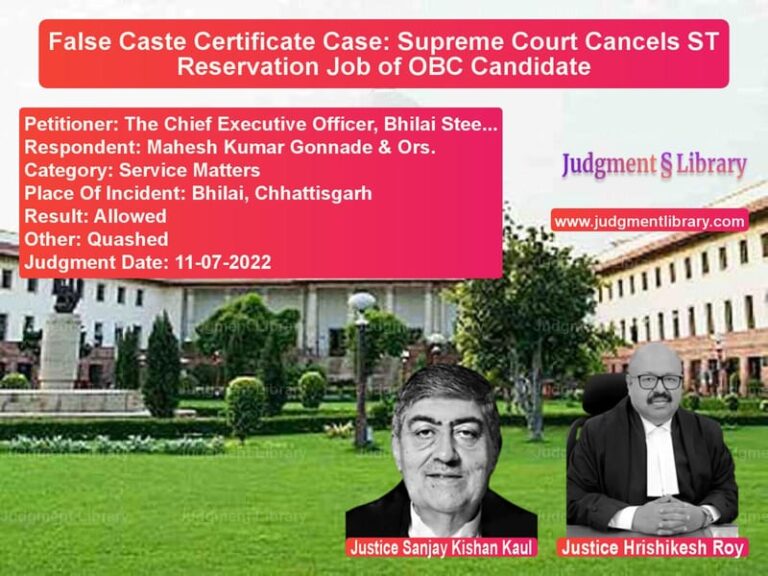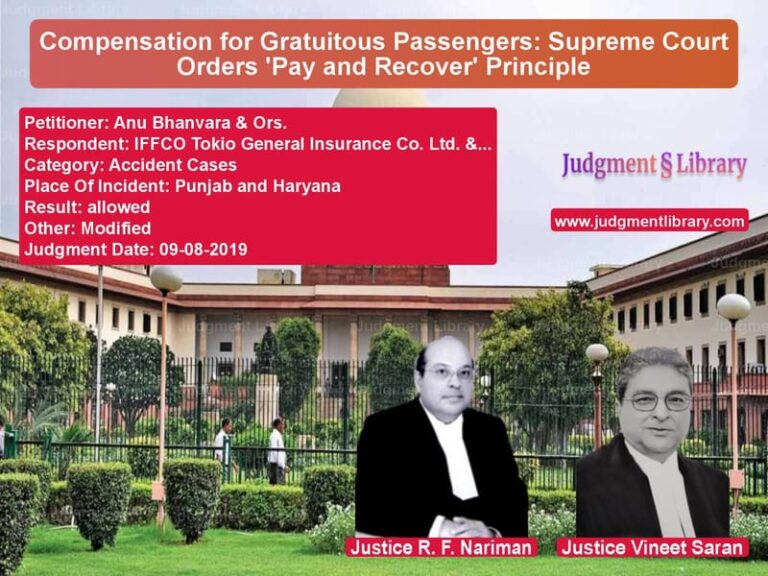Supreme Court Upholds Murder Conviction Based on Circumstantial Evidence and Last Seen Theory
In a landmark judgment delivered on May 30, 2025, the Supreme Court of India upheld the murder conviction of Chetan, who was found guilty of killing his friend Vikram Shinde in 2006. The case, which had been winding through the judicial system for nearly two decades, presented a classic example of how circumstantial evidence, when properly established, can lead to a conviction even in the absence of direct eyewitnesses to the crime.
The case originated from an incident on July 10, 2006, when Chetan and Vikram Shinde were last seen together near Mahishyal bus stand. According to the prosecution, Chetan had borrowed Rs. 4,000 from one Ravindra Chavan to lend to the deceased, but the money was never returned despite repeated demands. This financial dispute allegedly led to an argument between the two friends, during which the deceased reportedly insulted Chetan, creating a motive for the crime.
The prosecution’s case was that Chetan took a 12 bore double-barrel gun from his grandfather on the pretext of going hunting and took the deceased to a sugarcane field in Shahapur village. There, he shot Vikram Shinde dead and subsequently misappropriated his gold chain and mobile phone. The dead body was discovered three days later on July 13, 2006, in a decomposed state in the sugarcane field belonging to Arun Kumar Minache (PW-1).
Read also: https://judgmentlibrary.com/supreme-court-cancels-bail-in-murder-case-land-dispute-turns-deadly/
Before the Supreme Court, Mr. D.N. Goburdhun, learned Senior Counsel for the appellant, strenuously argued that “the Prosecution had not been able to prove that the appellant and appellant alone was responsible for the death of the deceased as there was no eyewitness to the incident.” He further contended that “Even the ‘last seen’ incident on which the Prosecution has heavily relied upon cannot be said to have been proved.” The defense challenged the credibility of prosecution witnesses, describing some as “interested witnesses” and others as “chance witnesses” whose testimony couldn’t be relied upon.
Regarding the recovery of evidence, the defense argued that “the D.B.B.L gun was not seized at the instance of the appellant and in fact, it was the grandfather of the appellant who had produced the gun when the Police came to his residence.” The ballistic report was also questioned, with the defense submitting that “the ballistic report itself is doubtful.”
On the other side, Ms. Eesha Bakshi, learned counsel appearing for the State, contended that “all the circumstances leading to the guilt of the appellant have been proved which would only lead to the inference that the appellant and appellant alone was responsible for murdering the deceased.” The State counsel emphasized that “there were as many as five eye-witnesses who had seen the appellant with the deceased the evening before his dead body was found three days later.”
The State further argued that “the appellant had remained absconding during the aforesaid period from 11.07.2006 to 22.07.2006 when the Police ultimately arrested him on 22.07.2006 in Miraj. That abscondence and his attempt to mislead others is clearly proved by the evidence of his own friend and classmate Devraj Sutar (PW-14).”
The Supreme Court, in its analysis, began by reiterating the fundamental principles governing cases based on circumstantial evidence, quoting from the celebrated case of Sharad Birdhichand Sarda v. State of Maharashtra: “It is well to remember that in cases where the evidence is of a circumstantial nature, the circumstances from which the conclusion of guilt is to be drawn should in the first instance be fully established, and all the facts so established should be consistent only with the hypothesis of the guilt of the accused. Again, the circumstances should be of a conclusive nature and tendency and they should be such as to exclude every hypothesis but the one proposed to be proved. In other words, there must be a chain of evidence so far complete as not to leave any reasonable ground for a conclusion consistent with the innocence of the accused and it must be such as to show that within all human probability the act must have been done by the accused.”
The Court meticulously examined the “last seen together” theory, which formed a crucial part of the prosecution’s case. The Court noted that “The last seen theory is based on the evidence of five witnesses, namely, Jamir P. Mulla (PW-3), Ashok R. Shinde (PW-4), Ashok R. Jamadar (PW-5), Anil Babarao Bagat (PW-11) and Digvijay Shinde (PW-12).” After detailed analysis of each witness’s testimony, the Court concluded that the last seen theory stood firmly established.
Addressing the defense’s argument about the time gap between the last seen and discovery of the body, the Court referred to State of Goa v. Sanjay Thakran and Anr, observing: “From the principle laid down by this Court, the circumstance of last seen together would normally be taken into consideration for finding the accused guilty of the offence charged with when it is established by the prosecution that the time gap between the point of time when the accused and the deceased were found together alive and when the deceased was found dead is so small that possibility of any other person being with the deceased could completely be ruled out.” However, the Court clarified that “in all cases, it cannot be said that the evidence of last seen together is to be rejected merely because the time gap between the accused persons and the deceased last seen together and the crime coming to light is after (sic of) a considerable long duration.”
The forensic and ballistic evidence played a pivotal role in the Court’s decision. The ballistic expert, N.G. Prabhakar (PW-30), had provided crucial opinions, including that “The D.B.B.L gun in Article No. 1 bears signs of discharge. The D.B.B.L gun in Article No. 1 was in working condition at the time of examination. The wads and lead pellets in Article Nos. 4 & 5 are the components of 12-bore cartridges and the same could have been fired through the D.B.B.L Gun in Article No. 1.”
The Court emphasized the significance of this scientific evidence, stating: “In our considered view, the aforesaid forensic evidence based on ballistic tests is not only crucial and critical in understanding the case, but also seals the fate of the appellant, which establishes the fact that the gun recovered at the instance of the appellant was used in causing the bullet injury to the deceased which led to his death.”
The Court also addressed the issue of the appellant’s conduct after the incident, noting that “the appellant remained in abscondence from 11.07.2006 till he was arrested by the police on 22.07.2006.” While acknowledging that “mere absconding by itself does not constitute a guilty mind as even an innocent man may feel panicky and may seek to evade the police when wrongly suspected of being involvement as an instinct of self-preservation,” the Court held that “the act of abscondence is certainly a relevant piece of evidence to be considered along with other evidence and is a conduct under Section 8 of the Evidence Act, 1872, which points to his guilty mind.”
Regarding the motive for the crime, the Court referred to G. Parshwanath vs. State of Karnataka, observing: “The argument that in absence of motive on the part of the appellant to kill the deceased benefit of reasonable doubt should be given, cannot be accepted. First of all every suspicion is not a doubt. Only reasonable doubt gives benefit to the accused and not the doubt of a vacillating judge.” The Court further noted that “in a case based on circumstantial evidence where proved circumstances complete the chain of evidence, it cannot be said that in absence of motive, the other proved circumstances are of no consequence.”
The Court made significant observations about the nature of circumstantial evidence, stating: “The present case is clearly one that is founded on circumstantial evidence. By its very nature, circumstantial evidence as opposed to direct evidence, is the inference one draws from the existence of a fact based on certain established fact/circumstance. This process invariably involves intuitive reasoning, proper understanding of human behaviour and psychology.”
In its concluding remarks, the Court emphasized: “It is also settled that where the evidence is circumstantial in nature, the circumstances from which the inference of guilt is to be drawn, should be fully established. In other words, each of the circumstances from which certain inferences are sought to be drawn, is required to be proved in accordance with law, and there cannot be any element of surmise and conjecture, and each of these circumstances so proved must form a complete chain without any break to clearly point to the guilt of the accused person.”
The Supreme Court ultimately dismissed the appeal, upholding the conviction under Section 302 of IPC (murder) and under the Arms Act, while giving the appellant benefit of doubt regarding the recovery of the mobile phone under Section 404 of IPC. The Court directed the appellant to surrender before the Trial Court to undergo the remaining period of his sentence.
This judgment reinforces the importance of circumstantial evidence in criminal jurisprudence and demonstrates how a combination of last seen theory, forensic evidence, recovery of weapon, and conduct of the accused can create an unbreakable chain of circumstances leading to conviction, even in the absence of direct eyewitness testimony.
Petitioner Name: Chetan.Respondent Name: State of Karnataka.Judgment By: Justice Surya Kant, Justice Nongmeikapam Kotiswar Singh.Place Of Incident: Shahapur village, Karnataka.Judgment Date: 30-05-2025.Result: dismissed.
Don’t miss out on the full details! Download the complete judgment in PDF format below and gain valuable insights instantly!
Download Judgment: chetan-vs-state-of-karnataka-supreme-court-of-india-judgment-dated-30-05-2025.pdf
Directly Download Judgment: Directly download this Judgment
See all petitions in Murder Cases
See all petitions in Attempt to Murder Cases
See all petitions in Fraud and Forgery
See all petitions in Theft and Robbery Cases
See all petitions in Judgment by Surya Kant
See all petitions in Judgment by N. Kotiswar Singh
See all petitions in dismissed
See all petitions in supreme court of India judgments May 2025
See all petitions in 2025 judgments
See all posts in Criminal Cases Category
See all allowed petitions in Criminal Cases Category
See all Dismissed petitions in Criminal Cases Category
See all partially allowed petitions in Criminal Cases Category

